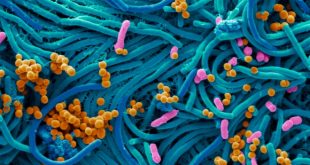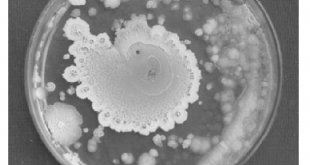Soil Microbiology is concerned with the study of all biological aspects of the microorganisms (bacteria, archaea, viruses, fungi, parasites and protozoa) that exist in the soil environment. However, before going ahead with the discussion of the functions and facts of microorganisms in soil, first we need to know what the soil and its environment is!
What is soil?
Soil can be defined as the top layer of the earth’s crust. It is in fact an extremely complex, variable and living medium formed by mineral particles, organic matter, water, air and living organisms. Soil is considered to be the “skin of the earth” with interfaces between the lithosphere, hydrosphere, atmosphere of Earth, and biosphere.
An agricultural definition of soil is “A dynamic natural body on the surface of the earth in which plants grow, composed of mineral and organic materials and living forms”.
Microbiologically, the soil environment is unique in several ways:
- It contains a vast population of bacteria, actinomycetes, fungi, algae and protozoa.
- It is one of the most dynamic sites of biological interactions in nature and
- It is the region in which occur many of the biogeochemical reactions concerned in the destruction of organic matter, in the weathering of rocks, and in the nutrition of agriculture crops.
Roles of Soil
Best safe and secure cloud storage with password protection
Get Envato Elements, Prime Video, Hotstar and Netflix For Free
Best Money Earning Website 100$ Day
#1 Top ranking article submission website
1. Soils serve as media for the growth of all kinds of plants.
2. Soils modify the atmosphere by emitting and absorbing gases (carbon dioxide, methane, water vapor, and the like) and dust.
3. Soils provide habitat for animals that live in the soil (such as groundhogs and mice) to organisms (such as bacteria and fungi), that account for most of the living things on Earth.
4. Soils absorb, hold, release, alter, and purify most of the water in terrestrial systems.
5. Soils process recycled nutrients, including carbon, so that living things can use them over and over again.
6. Soils serve as engineering media for the construction of foundations, roadbeds, dams and buildings, and preserve or destroy artifacts of human endeavors.
7. Soils act as a living filter to clean water before it moves into an aquifer.
Composition of Soil
Most soils contain five basic components viz. Like it before mention that the soil is a very complex and dynamic medium, the composition can fluctuate on a daily basis.
- Air
- Water
- Mineral Matter
- Organic Matter
- Microorganisms
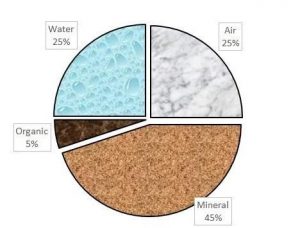
Composition of soil. Source here.
1. Air
Gases or air is the basic component of soil. Because air can occupy the same spaces as water. In soil, air pockets allow water to pass through the soil and into the plants growing above and below the soil line. Oxygen is essential for root and microbe respiration, which helps support plant growth. Carbon dioxide and nitrogen also are important for the belowground plant.
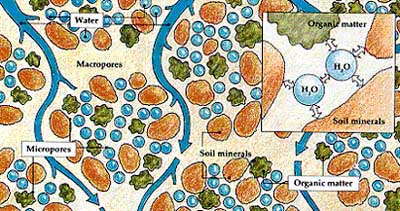
2. Water
Water is the second basic component of soil. Water is important for transporting nutrients to growing plants and soil organisms and for facilitating both biological and chemical decomposition. Soil water availability is the capacity of a particular soil to hold water that is available for plant use. The capacity of a soil to hold water is largely dependent on soil texture. The more small particles in soils, the more water the soil can retain.
3. Minerals
The largest component of soil is the mineral portion, which makes up approximately 45% to 49% of the volume. Soil minerals are derived from two principal mineral types. Primary minerals, such as those found in sand and silt. Secondary minerals, on the other hand, result from the weathering of the primary minerals, which releases important ions and forms more stable mineral forms such as silicate clay. Clay is the richest of soil minerals, containing nutrients like Iron, Potassium and Calcium.
4. Soil organic matter (SOM)
Organic matter is one of the important components of soil, consisting of plant and animal residues at various stages of decomposition of soil organisms. SOM increases soil fertility and acting as a reserve of plant nutrients, especially Nitrogen, Phosphorus, and Sulfur, along with micronutrients. There is a significant correlation between SOM content and soil fertility.
The SOM includes
- Identifiable, high-molecular-weight organic materials such as polysaccharides and proteins.
- Simpler substances such as sugars, amino acids, and other small molecules.
- Humic substances.
Sources of SOM
- The primary source of organic matter in the soil is plant and animal debris entering into the soil. In forest or prairies, as well as agricultural fields, dead plants, trees, shrubs, grasses, are transformed by animals and different kinds of living organisms. This process involves several steps.
- The microorganisms that work on that decomposition chain are themselves part of the soil organic matter.
- There are also other animals that consume living vegetal material, whose residues are passed to the soil. The products from the living organism’s metabolism are the secondary sources of soil organic matter that also includes the dead corpses of these organisms. Some animals, like earthworms, ants, centipedes contribute to the horizontal translocation of organic material.
Humus: A brown or black organic substance consisting of partially or wholly decayed plant or animal matter that provides nutrients for plants and increases the ability of soil to retain water is called Humus. It makes the upper layers of the soil become dark. Plants and animals remain incorporating into the soil, get subjected to decomposition from the original material. After further decomposition, these are converted to brown to black organic complexes remaining no longer any trace of original material. Humus provides soil with a number of very important benefits. As follow:
- It enhances a soil’s ability to hold and store moisture.
- It reduces the eluviation of soluble nutrients from the soil profile.
- It is the primary source of carbon and nitrogen required by plants for their nutrition.
- It improves soil structure which is necessary for plant growth.
5. Microorganisms
Microorganisms are the final basic element of soils, and they are found in the soil in very high numbers but makeup much less than 1% of the soil volume. A common estimate is that one thimble full of topsoil may hold more than 20,000 microbial organisms. The largest of these organisms are earthworms and nematodes and the smallest are bacteria, actinomycetes, algae, and fungi.
Each of these groups has different characteristics and different functions in the soil it lives in. Importantly, these organisms do not exist in isolation; they interact and these interactions influence soil fertility as much or more than the organism’s individual activities.
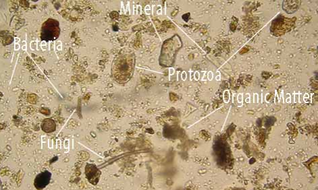
Major Microbial Groups In Soils
Bacteria (bacterium) – Bacteria are unicellular, prokaryotic microscopic cells. The bacteria are the smallest and the most numerous of the organisms in the soil. There are more than 400 named genera and an estimated 104 species. Species still unknown quite likely outnumber those already known. There are anywhere from 100 million to one billion bacteria in just a teaspoon of moist, fertile soil.
Actinomycetes (specialized bacteria)- unicellular to filamentous, prokaryotic organisms. They are often believed to be the missing evolutionary link between bacteria and fungi, but they have many more characteristics in common with bacteria than they do fungi.
Fungi – Fungi are mostly filamentous, eukaryotic. They group themselves into fibrous strings called hyphae. The hyphae form groups called mycelium which are less than 0.8mm wide but can get as long as several meters.
Algae and Cyanobacteria – Algae are unicellular to multicellular photosynthetic cells. The cyanobacteria (formerly the blue-green algae) are prokaryotes. All others are eukaryotic. Algae are present in most of the soils where moisture and sunlight are available. Their number in the soil usually ranges from 100 to 10,000 per gram of soil.
Protozoa – The single-celled, colorless, animal-like eukaryotic organism which is called Forerunners” of the animal kingdom. They are larger than bacteria, varying from a few microns to a few millimeters. Their population in arable soil ranges from 10,000 to 100,000 per gram of soil and are abundant in surface soil. They can withstand adverse soil conditions, as they are characterized by a protected, dormant stage in their life cycle.
Viruses – Viruses are not organisms in the strict sense of being cells. They are better thought of as genetic elements; particles composed of DNA or RNA generally surrounded by a protein coat, since they cannot reproduce unless they gain entry into a living “host” cell to do the job for them.
Table: Microbial groups with representative size, numbers, and biomass found in soil.
| Microbial group | Example | Size(µm) | Numbers (No. g-1 ) of soil |
| Bacteria | Pseudomonas | 0.5×1.5 | 108-109 |
| Actinomycetes | Streptomyces | 0.5×2.0 | 107-108 |
| Fungi | Mucor | 8.0 | 105-106 |
| Algae | Chlorella | 5×13 | 103-106 |
| Protozoa | Euglena | 15×50 | 103-105 |
| Viruses | Tobacco Mosaic | 0.02×0.3 | 1010-1011 |
Table: Relative proportions of aerobic, facultatively anaerobic bacterial genera commonly found in soils.
| Genus | Percentage |
| Arthrobacter | 5-60 |
| Bacillus | 7-67 |
| Pseudomonas | 3-15 |
| Agrobacterium | 1-20 |
| Alcaligenes | 1-20 |
| Flavobacterium | 1-20 |
| Corynebacterium | 2-20 |
| Micrococcus | 2-20 |
| Staphylococcus | <5 |
| Xanthomonas | <5 |
| Mycobacterium | <5 |
Ecological classification of Soil Microbes
Bacteria are usually the most abundant group in soils in terms of numbers. Winogradsky devised an ecological classification of the soil bacteria population. Soil Bacteria can be divided into two broad categories,
- Indigenous
- Allochthonous.
1. Indigenous – Indigenous bacteria are true residents of the soil, which may have resistant stages (endospores, spores, cysts) and endure for long periods without being active metabolically. However, at some time, these natives proliferate and participate in the biochemical functions of the community. Indigenous population could be two groups:
- Autochthonous – organisms that do not show a marked increase or fluctuations in numbers in response to the addition of an available carbon source to the soil. For example, many actinomycetes could be considered to meet this description. Organisms that do not rush to reproduce just because of a sudden influx of nutrients.
- Zymogenous – organisms that exhibit a tremendous increase in numbers in response to the addition of available carbon sources to the soil. Organisms that can take advantage of any sudden increase of nutrients in their environment which enable them to reproduce quickly and abundantly.
2. Allochthonous – Allochthonous bacteria are transients or invaders in the soil habitat, which enter the soil with precipitation, diseased tissues, animal manures, sepage effluent, sludges, etc. May persist as resting forms and sometimes even grow for short periods. Do not contribute significantly to ecologically important transformations in the soil.
Significance of Microbes in Soil
Role of bacteria
- They are decomposers, eating dead plant material and organic waste.
- By doing this, the bacteria release nutrients that other organisms could not access. The bacteria do this by changing the nutrients from inaccessible to usable forms. The process is essential in the nitrogen cycle.
- Nitrogen-fixing bacteria that fix nitrogen for plant growth are widely available in most soil e.g., Rhizobium, Azotobacter and Clostridium are free-living soil bacteria that fix nitrogen without a plant host.
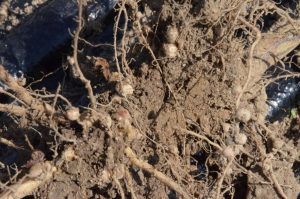
Role of Actinomycetes
- Actinomycetes give soil its characteristic smell.
- They have also been the source of several significant therapeutic medicines.
Role of Fungi
- Decomposers – saprophytic fungi – convert dead organic material into fungal biomass, carbon dioxide (CO2), and small molecules, such as organic acids.
- Mutualists– the mycorrhizal fungi – colonize plant roots. In exchange for carbon from the plant, mycorrhizal fungi help to make phosphorus soluble and bring soil nutrients (phosphorus, nitrogen, micronutrients and perhaps, water) to the plant.
- Parasites – The third group of fungi, pathogens or parasites, causes reduced production or death when they colonize roots and other organisms.
Role of Algae
- Play an important role in the maintenance of soil fertility, especially in tropical soils.
- Adding organic matter to the soil when they die and thus increasing the amount of organic carbon in the soil.
- Acting as a cementing agent by binding soil particles and thereby reducing and preventing soil erosion.
- Helping to increase the water retention capacity of soil for longer time periods.
- Liberating large quantities of oxygen in the soil environment through the process of photosynthesis.
- Helping in the weathering of rocks and the building up of soil structure
Role of Protozoa
- Most protozoans derive their nutrition from feeding or ingesting soil bacteria and, thus, they play an important role in maintaining bacterial equilibrium in the soil.
- Some protozoa have been recently used as biological control agents against organisms that cause harmful diseases in plants.
Role of Virus
- Soil viruses are of great importance, as they may influence the ecology of soil biological communities through both an ability to transfer genes from host to host and as a potential cause of microbial mortality.
- Consequently, viruses are major players in global cycles, influencing the turnover and concentration of nutrients and gases.
Soil as a Culture Medium for Microbes
- Soil contains air, free water, organic matter and mineral matters which are essential for the growth of microorganisms. On a volume basis, well-drained soil may contain 40% water, which is available to soil microbes for respiration and growth. The water in good agricultural soil may be considered a dilute nutrient broth. It contains, in solution, ion like K +, Na + , Mg 2+ , Ca2+, Fe 3+, NO3– , SO42- , CO32- , PO43- and others.
- Like water, soil also contains 25% air. Most soil bacteria are aerobic to facultative and practically all actinomycetes and molds require free oxygen for their respiration and growth.
- The pH of top good soil ranges from 6.0 to 8.0 at which most kinds of soil microorganisms grow best.
- The temperature of soil varies from day to day, controlled by climate. Most soil microbes grow best at temperature between 15-45ºC (Mesophiles) while psychrophiles grow at lower temperature and thermophiles grow at higher temperature.
- Available free oxygen, hydrogen donor and acceptor play a vital role in microbial growth.
Above mentioned conditions are very much suitable for a culture medium for microbial growth.
Written by
Shefa Ahsan, B.S (Hons), Department of Botany, University of Dhaka.
Revised by
- Md. Siddiq Hasan on 30 August, 2020.
- Somudro Mahbub Nasir on 7 July 2021.
Best safe and secure cloud storage with password protection
Get Envato Elements, Prime Video, Hotstar and Netflix For Free
 Plantlet The Blogging Platform of Department of Botany, University of Dhaka
Plantlet The Blogging Platform of Department of Botany, University of Dhaka




